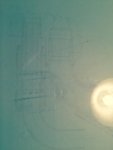I have a blueprint that was framed and in storage. I dug it out recently to hang it up, and it was completely faded (you can barely see the lines if you look sideways). It just looks like a tan sheet of paper now.
It’s a cool original (A Ferrari 288 GTO engine) – does anyone know of a process or service that can restore something like this?
Thanks!
It’s a cool original (A Ferrari 288 GTO engine) – does anyone know of a process or service that can restore something like this?
Thanks!


